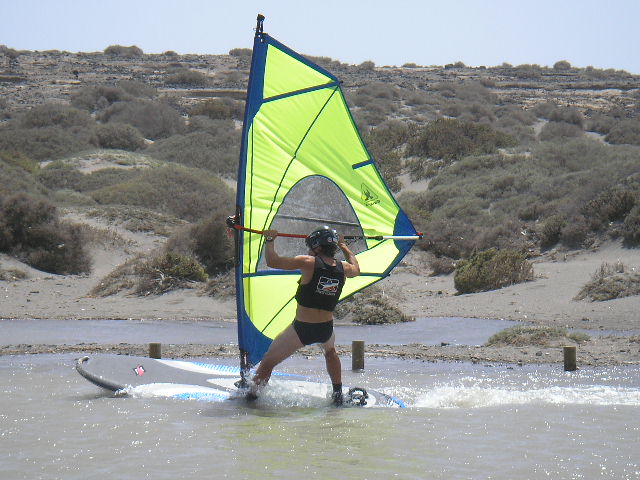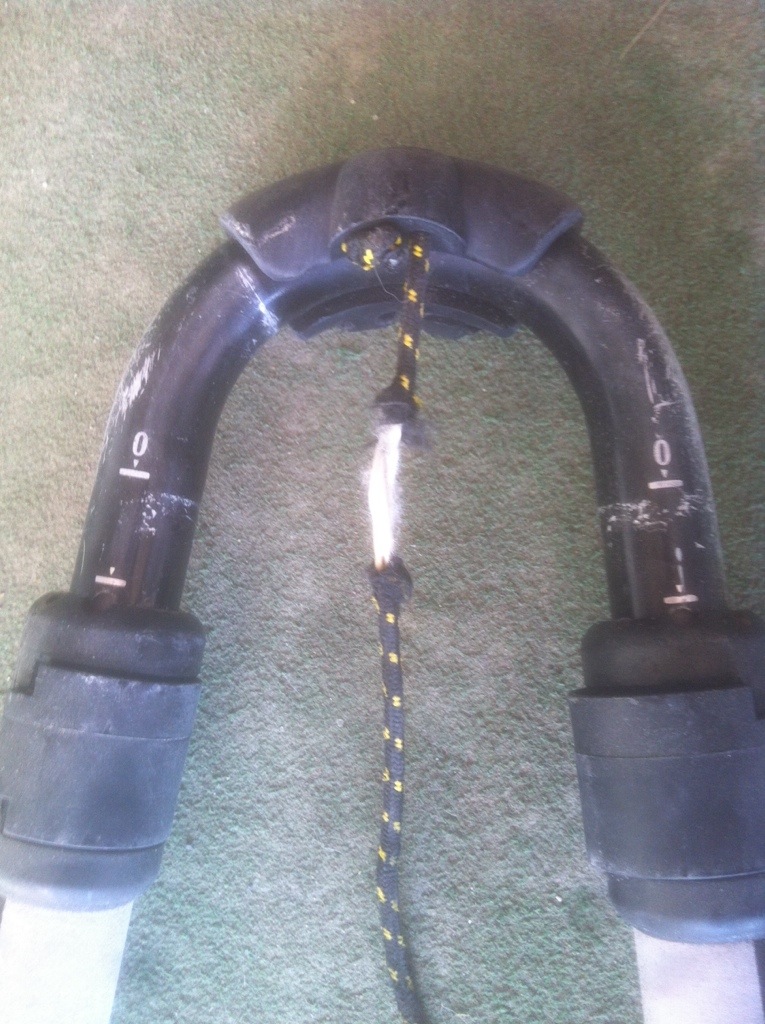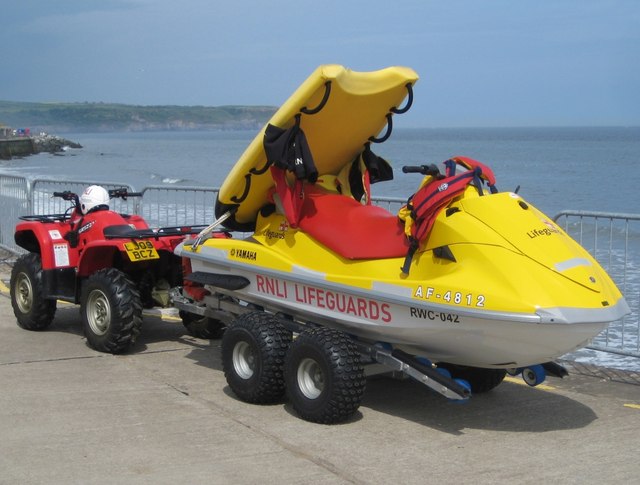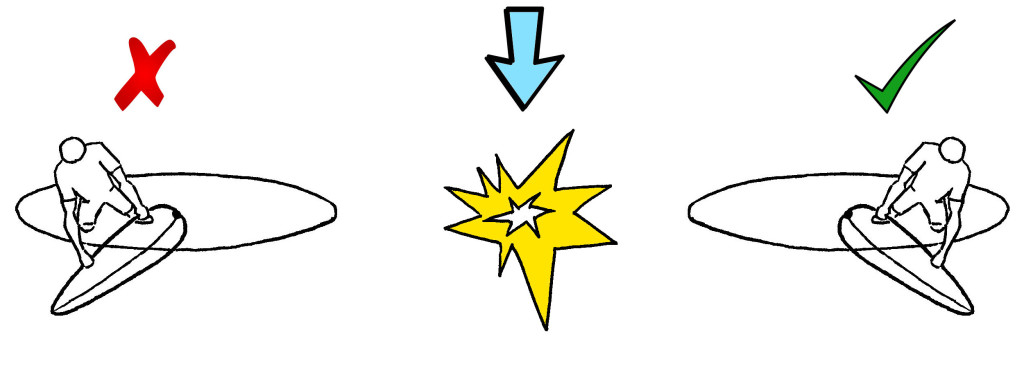Windsurfing is a potentially dangerous sport. In fact it is considered an extreme sport for a reason. That reason is mainly the fact that it is carried out in an environment we cannot control, namely the sea, lake, etc. Other sports offer security in terms of reduced risk of injury or equipment failure. Risk is the relation between the probability of something negative happening and the severity of the consequences of it happening. Both these factors are pretty high in windsurfing as we are traveling at important speeds, using gear that is subjected to high stresses and are in an environment that is not exactly a good place to be in if injured or with broken equipment. I know I would rather have a broken leg or be unconscious (not that I want any of these…) on firm land than in water.
Despite this fact, safety is often disregarded. I must confess that I am guilty of not sailing with a helmet or a lifejacket, sailing in offshore winds and not inspecting the gear properly before every use. That being said, my home spot tends to have side-onshore winds, an effective rescue service and waters full with other sailors. In any case it is important to know what can go wrong and make sure to take precautions to minimize the probability of it occurring and to reduce the graveness of the consequences if it does happen.
Inspect the kit
Looking over the windsurfing gear before we go on the water takes no time at all and yet not many people make it a habit to do so. The few most important things to look for are the following.
Board
It takes quite an impact indeed to break a board in two. However, a board doesn’t just snap the first time it lands flat on the water. It take a number of hits before the materials give in. Take a look along the surface to see if there is an indented line across it where it may have started to delaminate. If it is the case it won’t be long until we land a jump and are suddenly left with two pieces.
Mast-foot
The power joint is made of rubber. With every use, the rubber will be pushed beyond its elastic limit to a certain degree. Add to this the corrosive elements such as UV rays and salt water and at some point cracks will appear. These cracks will get bigger with every extension until at some point the joint will just rip apart into two pieces. The last place you want this to occur is far away from the shore. Therefore, before every use, check the mast-foot.
Outhaul and downhaul ropes
It is important to remember that ropes wear out easily. The outhaul and the downhaul are often in the sand which leads to erosion of the fibres of the ropes. Once the outer layer of the ropes has eroded, the inside will not hold for long. The consequence of any of these two ropes ripping is that the sail loses tension therefore becoming practically useless. In the case that this should occur it is useful to have a spare rope with us. This doesnt take up much space as it can be wound up around the harness hook bar.
Sail
It makes sense not to hit the water with rips in the sail cloth. While a hole in the sail will not likely prevent us from getting back to shore, a small hole or rip can turn into a big hole with every bump, hit or wash in the waves in the same way that a crack in the windshield of the car will grow with every bump on the road.
Mast
A broken mast is the equivalent of being helpless in the water as you can no longer use the sail in any way at all. Even with a loose outhaul or downhaul you can still lift the sail out of the water and kind of drift slightly across to the wind and get back to shore. A broken mast will not let you do this. Before putting the mast in the sleeve of the sail check it around the bottom and around where the boom is connected as these are the two areas most prone to break. Any cracks should be taken seriously.
Boom
Another thing that will render your sail useless is the boon breaking. This tends to happen at the head where it connects to the mast. Usually the creaking at that location will be an early enough warning for you to make sure you replace you boom before it snaps. You might think that the boom can still work in the other direction. After all, the holm on one side is still intact right? Wrong. The stability of the boom comes through the entirety. If it is broken on one side, the other will just bend with the force of the sail.
Know how to get back if you break your kit
Here is a very useful video for situations like breaking your boom or mast or losing the fin.
Not in a storm
I know that what the guys from the Red Bull Storm Chase do looks cool. And it is. But you should remember that these guys are professionals who have a lot of experience in extreme conditions AND who are aided by helicopters, jet skis, etc. I have pushed the limits to my windsurfing level many times including sailing in 40+ knot winds and mast high waves. However, in conditions like those I don’t experiment with maneuvers and I make sure I have the physical conditions to cope in a wipeout, etc.
Check forecast
Before heading out on to the water, it is wise to know what the weather is going to do. In some regions of the world the weather conditions can turn on you in a matter of minutes and I have heard a few stories of people being stuck out on the water in a sudden downpour. Despite this, in most places the weather forecasts are pretty accurate.
Not in offshore winds
The worst situation you can find yourself in is being blown offshore and unable to propel yourself to shore. If you are on a small lake you might say that eventually you will reach the other side. Sure, but how lone will that take and how long can you stay warm in the water? If you must go out in those circumstances, make sure there is an alternative (motorized) means of getting back, like a lifeguard with a jet ski.
No windsurfing at night
It might sound like a no brainer but please don’t be silly enough to go windsurfing at night. Sure there are events with loads of lights shone on the water for freestyle photos. But please don’t be stupid enough do do this on your own, or with a friend for that matter. It is just a plain unnecessary risk.
Safety Gear
When riding a bicycle you should wear a helmet, when driving you would wear your seatbelt, when climbing you should wear a harness, and when you go windsurfing you should take precautions to avoid injuries and reduce the consequences.
Helmet
Hits to the head are never a good thing. It doesn’t take high speeds to make a catapult ending in the head hitting the mast risky. I have only ever had two hits to the head with the mast, both from catapulting over a misjudged chop wave and both times were barely worth mentioning so I have never felt the urge to put on a helmet that makes me feel constrained even if only in visibility. However, I have heard stories of people and friends hitting their head on masts, boards, rocks, etc. and know that wearing a helmet will always be safer than not doing so.
Life Jacket
Life jackets are obligatory on Lake Garda. Of course they are a good idea since we are in a medium that drowns people who go unconscious (due to whatever resins, air insufficiency, hits to the head, etc.). Personally, like the helmet, I feel uncomfortable wearing one. I don’t like being pressed up against the sail when I am under it and I feel constrained in my movements. As with the helmet, I recognize that it is a good idea but I just don’t do it. The day I drown because of failing to wear one it will have been my own fault.
Flares
If you are going to be on the water close to the dusk in non-favourable conditions (which I don’t fora moment suggest you should ever do) make sure that if something does happen that you are able to signal your location to the rescue services in the dark. This means a flare. However, as I said before, you shouldn’t be windsurfing at night anyway…
Know the basic knots
The 3 basic knots every windsurfer should know are the square knot, the bowline and the clove hitch.
Not intoxicated
This may sound like a no-brainer but it should be said of people with no brain. As much as we enjoyed Matt recovering from his hangover by surfing, heading onto the water intoxicated by whatever substance that reduces our reflexes and our decision making ability is just plain irresponsible.
Ensure emergency services are available
I know that many great spots will be far away from frequently transited places. As enticing as they may be, we must take the time to make a reasonable assessment of the dangers of something going wrong and the likelihood of something unfortunate happening. Analyzing waves, the reef, currents and possible exit points are a good starting point. On top of this try to avoid windsurfing in places where emergency services are not readily available. The longer you have to wait for rescue, the more unlikely it is for them to find you as the possible displacement from where you were last seen to where to end up with wind, waves, current and your own attempts to get yourself to safety through swimming or sailing will increase with every minute.
Don’t go on the water alone
Even if there is an emergency service available. They will not go looking for you if they do not know someone needs to be saved. Make sure that someone on shore knows that you are going on the water, how long you will be and how you will notify them when you get back. Apart from this it is also wise to not go windsurfing at a spot if we are the only ones out. I am the first to appreciate how awesome it is to not have to back out of a wave due to someone else being on it already or some reckless idiot jumping in the wave that has lined up perfectly for you. However, in terms of safety, it is helpful, comforting, etc. if you have the ability to let someone know as soon as you are in trouble rather than have to wait for someone to notice.
Know the rules of right of way
In places where there is a lot of traffic on the water it can look a bit like the roads in India. To make sure the accidents are kept to a minimum we need to know the rules of right of way. In El Médano I must admit that this is not the case. Many people simply refer to the manouver of the last instant. The problem is that this may not be likely to change as just one or two people acting according to the rules won’t change other peoples behavior. However, if you are involved in an accident and it turns out to be your responsibility because you didn’t give way or held your course, you might face legal consequences.
Know how to get back without sailing
This is a big one. Know the different techniques at your disposal for getting back to the shore if either the wind drops, you injure yourself or if you break your kit. I have already written on different means of getting back to the shore if the wind drops. SurferToday also wrote a post on self rescue which you can read here.











Trackbacks/Pingbacks